[四国EPO・四国ESDセンターが、みなさんにおすすめしたい!と思った事例をご紹介していきます]
環境で大月町を元気にしたい / Revitalizing Ōtsuki Town Through the Environment / 用环境让大月町充满活力
高知県の最西端にある幡多郡「大月町」。環境省の事業である「地域循環共生圏づくりプラットフォーム事業」が、2022年度からこの町で展開されています。この事業は「環境で地域を元気にする」というコンセプトです。
大月町は海岸部を中心に足摺宇和海国立公園に指定されており、透きとおるように青く美しい海と色とりどりのサンゴ礁に出会える「柏島」をはじめ、「樫西海岸」や「大堂海岸」など海の絶景が拡がります。その豊かな海を支えるのに欠かせない存在である森林は、豊かな栄養分を海へと注ぐ役割を担っています。
大月町では、この森林を舞台に官民が連携して様々な取組を進めています。広葉樹活用学習会やチェーンソー安全講習、薪の販売講習会、自伐型林業研修など、「山に興味を持つ人を増やす」ことがそれぞれの取組の目指すべき目標になっています。
いきなり山の仕事だけで生活が成り立つ人は難しいかもしれませんが、お茶をつくったり黒炭を焼いたり、子どもたちに体験の機会を開いたり、家具をつくったり、チェーンソーを使って作業をする人など、学びと実践を通じた輪が広がっています。「ぼちぼち林業」「山業(さんぎょう)」を増やすという、大月町ではじまった取組に注目しています。
「地域循環共生圏づくりプラットフォーム事業」について詳しく知りたい方は下記HPをご覧ください。
http://chiikijunkan.env.go.jp/tsunagaru/
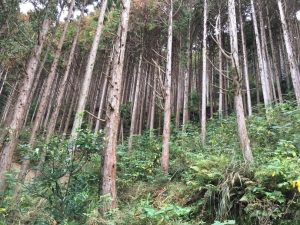
Revitalizing Ōtsuki Town Through the Environment
Hata District’s Ōtsuki Town is located at the westernmost point of Kōchi Prefecture. Here, the “Regional Circular and Ecological Sphere (R-CES) Development Platform Project,” a Ministry of the Environment initiative, has been underway since the 2022 fiscal year. The project is centered around the concept of “revitalizing the area through the environment.”
The coastal areas of Ōtsuki Town are designated as part of Ashizuri-Uwakai National Park. From the crystal-clear blue water and colorful coral of Kashiwajima, to the beautiful Kashinishi and Odo coasts, there’s no shortage of spectacular sea views to be found. Forests play an indispensable role in supporting this rich marine ecosystem by delivering an abundance of nutrients to the sea.
In Ōtsuki Town, various initiatives focused on the forests are being advanced through public-private partnerships, all aimed at increasing the number of people interested in the mountains. Some examples include a seminar about effectively utilizing broad-leaved trees, chainsaw safety training, a short course on firewood sales, and training in self-harvest forestry.
While suddenly making a living solely from mountain-related work may be challenging, a community of learning and practice is slowly but surely expanding. This community includes people who make tea, produce charcoal, create hands-on experiences for children, craft furniture, and work with chainsaws. Special attention is being paid to efforts started in Ōtsuki Town to increase “gradual forestry” and “mountain industry.” For more information on the “R-CES Development Platform Project” please visit the official website.
http://chiikijunkan.env.go.jp/tsunagaru/
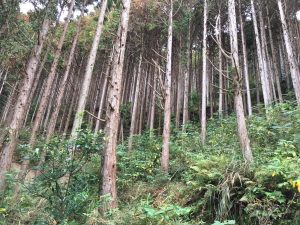
用环境让大月町充满活力
幡多郡“大月町”位于高知县最西端。从2022年开始环境省的事业“打造区域循环共生圈的平台事业”在这个城镇开展。这个事业的理念是“用环境让地区充满活力”。
大月町的海岸部中心是已被指定为足摺宇和海国立公园,以能与碧蓝透明的美丽大海和五颜六色珊瑚礁相遇的“柏岛”为首,还有“樫西海岸”和“大堂海岸”等海的绝景而展开。森林是支撑丰富海洋不可或缺的存在,有着向大海注入丰富营养成分的作用。
在大月町,以这片森林为舞台,官民联合开展各种活动:阔叶树活用学习会、电锯安全讲习会、柴火销售讲习会、自伐型林业研修会等,“增加对山林感兴趣的人”是每个活动应该的目标。
只靠山里的工作就立刻能维持生活可能很难,但是可以做茶、烧黑炭,给孩子们提供体验机会,制作家具,使用电锯工作的人等,通过学习和实践让他们的圈子在扩大。 “零星林业”和“山林业”逐渐增加,从大月町的活动开始受到了关注。想了解更多关于<打造区域循环共生圈的平台事业>的情况,可阅览官网。
http://chiikijunkan.env.go.jp/tsunagaru/

四国ESDまつり / Shikoku ESD Festival / 四国ESD祭
■「ESD」が公園に集合!
ESD活動推進拠点「善通寺こどもエコクラブ」が呼びかけ人となり、香川県善通寺市の「善通寺五岳の里」市民集いの丘公園で、最初に「ESDまつり」を開催したのは2016年。「香川ESDまつり」として開催し、その後、新型コロナウイルス感染症拡大防止のため休止していましたが、2023年3月21日、「四国ESDまつり」として再開しました。田代商店、セカンドハンド、高松ユネスコ協会、halqa(はるか)、コープ自然派、香川大学・SteeeP、香川県青年海外協力協会、うどんまるごとコンソーシアム、愛媛ダイビングセンター、ESD実践者が集い、それぞれの活動を紹介する展示、リサイクル商品や自然食品、フェアトレード商品の販売、古着のリメイク、苔玉盆栽づくりの体験など、ESDを実践する人と人が出会い、お互いの活動を知り、ヨコにつながる機会となりました。
その「つながりづくり」は、午前中のプログラム、善通寺第一高等学校生有志による「探究学習の発表」から始まったと言えるでしょう。高校生たちは、図書利用度向上、ウクライナ支援と平和、交通事故予防ロボットといった高校生目線で捉えたテーマ・課題が、どのようにSDGs(持続可能な開発目標)達成につながるのか、調べては動き、動いては分析しながら学び、そこで得たさらなる課題に向き合い、次の動きへと展開するESD実践を発表してくれました。
午後は、高校生たちが全ての展示・参加者にインタビューしながら、それぞれの活動や取組への思いを紹介してくれました。これらを受けて、最後にESDに長く関わる実践者のトークもありました。五岳の里は、2010年、市民の願いが結実して造られた自然公園です。近隣には古墳があり、柑橘類の栽培も行われていたようですが、今は市民が集う公園となりました。桜をはじめ、たくさんの種類の樹木と触れ合い、今の季節はチューリップなど、たくさんの花に囲まれ、ヤギとの触れ合いも体験できる自然公園です。この「四国ESDまつり」開催・参加による心の豊かさを実感できる時が刻まれ、新たなESDの芽が育まれていくことでしょう。
Shikoku ESD Festival
■ ESD Gathering at the Park!
The first time the ESD activity hub “Zentsūji Children’s Eco Club” hosted the Kagawa ESD Festival in Zentsūji’s “Zentsūjishi Gogakunosato” Shimin Tsudoinooka Park was 2016. It was later canceled to prevent the spread of COVID-19, then restarted on March 21, 2023, this time as the Shikoku ESD Festival. Various ESD practitioners, such as Tashiro Shouten, Second Hand, Takamatsu UNESCO Association, halqa, Coop Shizenha, Kagawa University’s SteeeP project, the Kagawa Overseas Cooperation Agency (JOCA-KAGAWA), the Udon Total Recycling Consortium and Ehime Diving Center, gathered to showcase their activities. The event featured exhibitions explaining what they do, sales of recycled goods, natural food products and fair trade products, as well as hands-on clothes remaking and kokedama bonsai making experiences. It provided a venue for people practicing ESD to meet, learn about each other’s activities, and create horizontal connections.
The networking began with the morning program, “Inquiry Based Learning Presentations,” hosted by motivated students from Zentsūji Daiichi High School. The students reported on their ESD practices, focusing on themes and issues that appealed to them as high schoolers, such as increasing library usage, supporting peace in Ukraine, and preventing traffic accidents with robots. They studied how these topics relate to the SDGs (sustainable development goals) through repeated cycles of investigation, action and analysis, finding new challenges to engage with and developing their next activities in the process.
In the afternoon, the students interviewed all of the exhibitors and participants while sharing their thoughts about each group’s activities and efforts. Afterward, the event concluded with a talk by seasoned ESD practitioners. Gogakunosato is a nature park created in 2010 due to the wishes of the citizens. There are ancient burial mounds nearby, and though it seems the land was once used for citrus cultivation, now it has become a place for people to gather and experience the natural world. Visitors can see all sorts of trees, including cherry blossoms, walk through fields of flowers, such as tulips, in the spring, and even interact with goats. The sense of fulfillment fostered by holding and participating in the Shikoku ESD Festival will surely nurture the growth of new ESD seedlings.
四国ESD祭
■“ESD”在公园集结!
ESD(Education for Sustainable Development)活动推进据点“善通寺儿童环保俱乐部”作为发起人,在香川县善通寺市的“善通寺五岳之里”市民集会之丘公园,于2016年首次举办了“ESD祭”。以“香川ESD祭”的名义举办,之后为了防止新型冠状病毒感染症的扩大而暂停,2023年3月21日,以“四国ESD祭”的名义再次举办。田代商店、Secondhand、高松联合国教科文组织协会、halqa(HARUKA)、Coop(消费生活协同组合,“生协”)自然派、香川大学·SteeeP、香川县青年海外合作协会、乌冬整体联盟、爱媛潜水中心,ESD实践者聚集起来,介绍和展示各自的活动,循环利用商品、自然食品、公平贸易商品的销售,旧衣服的改造,苔藓盆景的制作体验等,因实践ESD活动而让人们相识,了解彼此的活动,并出现了横向联合的机会。
这种“建立联系”的活动,上午的项目是从善通寺第一高等中学校的志愿学生的“探究学习发表”开始的。高中生们将提高图书利用度、对乌克兰的支援与和平、预防交通事故的机器人等以高中生视角捕捉的主题、课题与如何达成SDGs联系在一起,一边调查一边行动,在行动中分析和学习,从而发现和面向进一步的课题,并展示了ESD活动的下一步行动计划。
下午,高中生们一边采访所有的展示者和参加者,一边介绍了各自的活动和对组织活动的想法。在这些之后,最后还有长期从事ESD的实践者的演讲。五岳之里是2010年根据市民的愿望建造的自然公园。附近有古坟,也栽培柑橘类水果,现在成为市民聚集的公园。这里现在是一座最初从樱花开始,现在可以和多种树木亲密接触,在这个季节会被郁金香等众多花卉包围,以及体验与山羊亲密接触的自然公园。通过举办和参加“四国ESD祭”,铭记能够切实感受到心灵的丰富,新的ESD的萌芽也会被孕育吧。
特定非営利活動法人由良野の森 / Designated NPO Yurano no Mori / 特定非营利活动法人由良野之森
■生きものと共生し、活力を得るフィールド
愛媛県久万高原町二名地区の山間にありながら、県内外といわず、国内外から多様な人々が集う由良野の森。印象的な赤茶色の壁のゲストハウスのかたわらには小さな流れがあり、オタマジャクシやヤゴなどの水生昆虫もいるなと見ていたら、放し飼いのニワトリがそばで何かをついばんでいます。その先の小屋にはヒツジも。さらに小道を進むとクワの林と天然林、少し登るとスギ・ヒノキの人工林など、いろんな植生があり、わくわくしながら森の散策を楽しめます。
よい季節になると、子育て支援の団体が森のようちえんを開催したり、企業がCSRや職員の福利厚生として里地や森林の整備活動を行ったり、ゲストハウスにはお遍路さんや口コミでやって来る旅行者が宿泊したり。程よく人の手が入った自然の中でゆったりと過ごし、リフレッシュするフィールドであり、様々な人との出会い場にもなっています。
一方、中山間地域の集落での暮しは、過疎化が進むことによって地域の担い手としての負担が増える中、イノシシやシカなどの獣害が拡大し、気候変動による大雪や大雨などが多発傾向にあり、地域の持続可能性に不安を感じることが少なくないといいます。このように山積する課題の中でも、50年先を展望して「今着手しなければ」と、由良野の森が推進するのが、「ブナの森づくりプロジェクト」です。
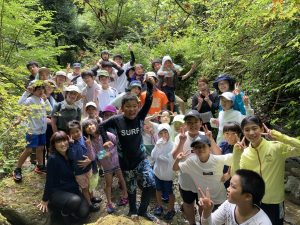
由良野の森のそばを流れる川で沢のぼり!
■ブナの森づくりプロジェクト
全国的に奥山まで人工林が広がっていますが、適切な整備が行き届かなければ、下層植生が失われ、保水力が低下することなどによって、斜面が崩壊して水害をもたらすなどの危険が高まります。そこで、人間が管理しなくても生態系が持続する、かつて奥山にあった自然林の再生を目指す「ブナの森づくりプロジェクト」をスタートさせました。
森の復元を加速させるためには、人工林の伐採跡地に苗を植える必要があります。そこで、その地域にもともとある樹種を選び、種子を採取し、播種し、苗を育てることに取り組んでいます。さらに、復元地の整備、定植、管理に至るまで、地道な取組を展開することとなります。そのために大切にしていることが、多様な立場やスキルを持つ人・組織との協働。例えば種子採取においては、フリースクールや森林保全を行うNPO、アウトドアショップともコラボして、各地の奥山で種を採取しました。育苗については、水やり等の管理を福祉サービス事業所に委託し、障がいのある人の仕事を作り出しています。また、植物や森林の研究者の協力を得て、科学的な知見に基づいて活動を計画し実証するとともに、山林の所有に関する様々な問題には、弁護士や司法書士などの専門家と解決に取り組む体制を構築しています。
関わった人・組織が、奥山の現状や中山間部を守る生活について知り、ともに考えて活動することを通して、それぞれの立場で持続可能な森づくりの担い手となることが大切であると考えているのです。
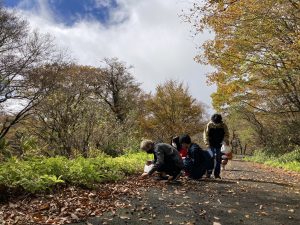
フリースクールの仲間たちと種拾い
■森の復元を横展開
50年後の社会構造や環境を想定しつつ、中長期のビジョンとしては、放置林の問題、山林における土地所有の問題、木材利用の付加価値の創出など、様々な社会課題も同時に解決する森づくりを目指し、自然再生推進法のもとで、自然再生協議会を立ち上げる方針です。
そして、全国でも森林の整備・維持については同様の課題があるため、まずは四国で「ブナの森づくりプロジェクト」の手法を横展開することを目指し、令和5年2月に「ローカルSDGs四国」において分科会「四国の奥山自然再生協議会準備会」を発足させました。
※ローカルSDGs四国(LS四国)https://ls459.net/
※分科会「四国の奥山自然再生協議会準備会」https://ls459.net/?page_id=4358
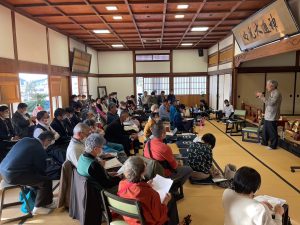
森の復元プラットフォームセミナーの様子
自然の中で過ごす時間に興味がある方、由良野の森では、初めてでも参加しやすい「森のおさんぽとおはなし会」などを定期的に実施しています。森から活力を得るとともに、自然との関わり方を見つめなおす機会になるでしょう。
※由良野の森HP https://yuranonomori.jp/
Designated NPO Yurano no Mori
■ Finding Renewal Through Coexistence With Nature
Located in the mountainous Nimyō district of Kumakōgen, Ehime, Yurano no Mori attracts a wide variety of visitors from both inside Japan and abroad. Near the guest house and its striking reddish-brown walls, a small stream flows, teeming with tadpoles, dragonfly larvae and other aquatic life. Alongside it, free-range chickens peck at the ground, while a sheep pen stands in the distance. Advancing further along the path reveals mulberry and naturally regenerating forests, and beyond that, planted forests of Japanese cedar and Japanese cypress. With such a diverse range of vegetation, guests can enjoy exploring the forest with a sense of excitement.
In favorable seasons, childcare support organizations run a forest kindergarten, companies engage in forest maintenance activities to promote CSR and employee welfare, and the guest house hosts pilgrims and travelers drawn in by word-of-mouth advertising. Nature, thoughtfully cultivated by human hands, provides a space for relaxation and rejuvenation, while fostering connections between visitors from various walks of life.
On the other hand, the growing burden of depopulation on the residents, alongside expanding wildlife damage from boars and deer and an increase in severe weather events like heavy snow and rain due to climate change, has raised concerns about the sustainability of rural mountain life. Nevertheless, even in the face of these challenges, Yurano no Mori is looking ahead to the next fifty years and taking a “now or never” approach, moving forward with the Beech Forest Creation Project.
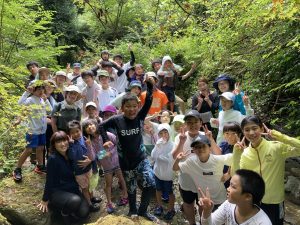
<Stream climbing in the river by Yurano no Mori!>
■ Beech Forest Creation Project
Although planted forests have proliferated throughout the country, even deep in the mountains, without proper care and maintenance their understory vegetation will be lost, and the reduced water retention capacity can lead to an increased risk of slope failure and flooding. In response, the Beech Forest Creation Project was initiated to restore the naturally regenerating forests that once thrived in these deep mountain areas, which are capable of sustaining themselves without human intervention.
To accelerate the forest’s restoration, it is necessary to plant saplings at the logging sites of planted forests. Efforts are underway to select species native to an area, gather seeds, sow them and raise the saplings. Not only that, serious consideration is being given to the preparation, cultivation, and management of the restoration sites. That’s why collaboration with people and organizations possessing a wide variety of perspectives and skills is vital. For example, seeds native to the mountains of various areas were gathered with the cooperation of Free Schools, forest conservation NPOs and outdoors shops, while tasks such as watering the seedlings were outsourced to welfare service offices, providing job opportunities for people with disabilities. Additionally, all activities are planned and validated based on scientific insights with the assistance of botanists and foresters, and there is a system in place to work together with legal experts such as lawyers and judicial scriveners to address various issues related to forest ownership.
It’s considered essential for all involved parties to learn about the current state of the deep mountains and lifestyles that preserve mountainous areas, and, through thinking and working together, to become stewards of sustainable forestry in their own ways.
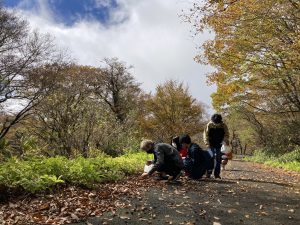
<Gathering seeds with Free School partners>
■ Scaling It Out
While forecasting the social and environmental landscape 50 years in the future, the mid-to-long term vision includes a plan to start a Nature Restoration Council under the Law for the Promotion of Nature Restoration in order to tackle various societal challenges such as the issue of neglected forests, land ownership in forested areas, and the creation of added value through timber use.
Also, because similar challenges in forest maintenance and preservation exist nationwide, the goal is to scale out the methodologies of the Beech Forest Creation Project, starting with the rest of Shikoku. To that end, in February 2023 the “Shikoku Deep Mountain Nature Restoration Council Preparatory Committee” was established as a subcommittee under Local SDGs Shikoku.
※Local SDGs Shikoku(LS Shikoku)https://ls459.net/
※ Subcommittee “Shikoku Deep Mountain Nature Restoration Council Preparatory Committee”
https://ls459.net/?page_id=4358
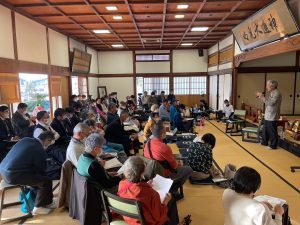
<Scene from the Forest Restoration Platform Seminar>
For those interested in spending time in nature, Yurano no Mori holds regular events that even beginners can enjoy, such as the “Forest Walk and Talk.” These outings provide an opportunity to draw energy from the forest and reconsider one’s relationship with the natural world.
※Yurano no Mori Official website https://yuranonomori.jp/
特定非营利活动法人由良野之森
■与生物共生,获得活力的场所
由良野之森虽然坐落在爱媛县久万高原町的二名地区的山间,却聚集了来自国内外的各种各样的人士。带来深刻印象的红褐色墙壁的民宿旁边有一条小河,河里有蝌蚪、水虿等水生昆虫,放养的鸡在旁边啄着什么。在它的前面的小屋里还有羊。再往前走,在小路上就能看到桑树林和天然林,再往上登高一些,就能看到杉树和柏树组成的人工林等,有各种各样的植被,可以尽情享受在森林里散步的乐趣。
一到好季节,育儿支援团体就会开办森林幼儿园,企业作为履行社会责任和给予职员的福利,也会在这里开展周边土地和森林的整备活动,民宿也会有通过参加四国遍路活动的遍路客和因口碑评论而来的游客入住。由良野之森能够让人在适度人工处理过的自然中悠闲生活,是得以放松精神的地方,也是与各种各样的人相遇的场所。
另一方面,在山间地区的村落的生活,由于人口过疏化的加剧,作为该区域(由良野之森)的负责人的负担也在增加:野猪和鹿等野兽的危害在扩大的同时,由于气候变化,暴雪和大雨等气象灾害也有多发的倾向,(由良野之森的负责人)对地区的可持续性感到不安。在堆积如山的课题中,由良野之森在展望50年后,认为“必须着手于现在”,从而推进了“山毛榉林建设项目”。

<散步在良野森林旁的河畔!>
■山毛榉树林建设项目
虽然全国范围内的深山内都有人工林,但是如果不进行适当的维护,由于下层植被丧失,保水能力下降等原因,导致斜坡崩塌并造成水灾的危险也会提高。因此,即使人类不进行管理,生态系统也能维持的,过去深山中自然林的再生为目标的 “山毛榉树林建设项目”启动了。
为了加速森林的复原,有必要在人工林的采伐地点种植幼苗。因此,开展了选择当地原有的树种,采集种子,播种,培育幼苗的工作。并且,从复原地的整备、定植到管理,都要逐步仔细的实施。为此,最重要的是与拥有不同技能的人、有组织的协同工作。例如,在种子采集方面,与自主教育学校、开展森林保护的非盈利组织、户外运动商店合作,在各地的深山采集种子。关于育苗,浇水等的管理委托给福利服务事业所,为残疾人创造了工作。此外,在植物和森林研究者的协助下,基于科学知识对活动进行计划和实证的同时,针对与森林所有权相关的各种问题构建了与律师、司法书士等专家共同解决问题的工作体制。
(由良野之森)认为,相关的人和组织要了解深山的现状和保护山中环境的生活方式,通过共同思考并开展活动,站在不同的立场上,成为可持续发展的森林的责任者。

<自主教育学校的伙伴们和拾种籽>
■森林复原的横向展开
在设想50年后的社会结构和环境状况的同时,作为中长期的方向,为实现同时解决放置林的问题、与山林有关的土地归属的问题、创造木材利用的附加价值等各种社会性课题的森林建设,在自然再生推进法的基础上,设定了创建自然再生协议会的方针。
并且,由于全国森林的整备·维持也有同样的课题,因此以将首先在四国开展的“山毛榉林建设项目”的方法横向展开为目标,令和5年2月在“Local SDGs(地域循环共生圈)四国”组织内,成立了作为分科会的“四国的深山自然再生协议会筹备会”。
※Local SDGs(地域循环共生圈)四国(LS Shikoku)https://ls459.net/
※分科会“四国的深山自然再生协议会筹备会” https://ls459.net/?page_id=4358

<森林的复原平台研讨会的样子>
对于对在大自然中度过的时间感兴趣的人,在由良野之森,会定期举办即使是第一次也很容易参加的“森林的散步和聊天会”。在从森林中获得活力的同时,也是重新审视与自然相处的方法的机会。
※由良野之森官网 https://yuranonomori.jp/



